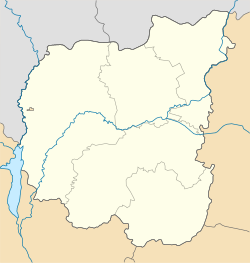Top Qs
Timeline
Chat
Perspective
Novhorod-Siverskyi
City in Chernihiv Oblast, Ukraine From Wikipedia, the free encyclopedia
Remove ads
Novhorod-Siverskyi (Ukrainian: Новгород-Сіверський, IPA: [ˈnɔu̯ɦorod ˈs⁽ʲ⁾iwersʲkɪj], Russian: Новгород-Северский, Novgorod-Severskiy), historically known as Novhorod-Siversk (Ukrainian: Новгород Сіверськ) or Novgorod-Seversk (Russian: Новгород-Северск), is a historic city in Chernihiv Oblast, northern Ukraine. It serves as the administrative center of Novhorod-Siverskyi Raion, although until 18 July 2020 it was incorporated as a city of oblast significance and did not belong to the raion. Novhorod-Siverskyi is situated on the bank of the Desna River, 330 kilometres (210 mi) from the capital, Kyiv. It hosts the administration of Novhorod-Siverskyi urban hromada, one of the hromadas of Ukraine.[1] The city's population is 12,375 (2022 estimate).[2]
Remove ads
History
Summarize
Perspective
The town was first chronicled in 1044. From 1098 it was the capital of the Siverian Principality, which served as a buffer zone against incursions of the Cumans (Polovtsy) and other steppe peoples. One of the numerous campaigns of local princes against the Cumans produced the great monument of early East Slavic literature, the Tale of Igor's Campaign.
After the town's destruction by Mongols in 1239, it passed to the princes of Bryansk and then to the Grand Dukes of Lithuania. It was ruled by Dymitr Korybut (Kaributas), son of Algirdas. Muscovy obtained the area following the Battle of Vedrosha in 1503, but lost it to Poland after the Time of Troubles, when it submitted to False Dmitry I in the Battle of Novhorod-Siverskyi. Nowogród Siewierski was granted Magdeburg city rights in 1620 by Polish King Sigismund III Vasa. It was the easternmost powiat (county) seat of Poland. The town passed to Russia as a result of the Russo-Polish War (1654–1667). During the Cossack epoch, it received the status of military company town (sotenne misto) and later regimental town (polkove misto); these were military and administrative divisions in the Cossack army and country. Also Novhorod-Siverskyi became a cultural center of Left-bank Ukraine. It was made the capital of a separate namestnichestvo in 1782–97. Thereafter its importance steadily declined.
During World War II, Novhorod-Siverskyi was occupied by the German Army from 26 August 1941 to 16 September 1943.
Until 18 July 2020, Novhorod-Siverskyi was designated as a city of oblast significance and did not belong to Novhorod-Siverskyi Raion even though it was the center of the raion. As part of the administrative reform of Ukraine, which reduced the number of raions of Chernihiv Oblast to four, the city was merged into Novhorod-Siverskyi Raion.[3][4]
The city was occupied with Russian forces from 24 February to 2 April[5] 2022. This caused a humanitarian crisis in the city and forced many civilians to evacuate.[6] Russian troops blocked the entrances and exits of the city with tanks, not even allowing ambulances. At checkpoints, local residents' phones were forcefully taken and broken. The city council destroyed documents related to the Donbas war participants to protect them from Russian troops.[7] On 12 May 2022, the Russian army fired several missiles at a local school, killing three and wounding 19 people.[8]
Remove ads
Architecture
Summarize
Perspective
Despite historic disasters, the town has preserved many architectural monuments, and a branch of the Chernihiv State Historical and Architectural Reserve had been established, which since 1990 has become a separate historical-cultural reserve named after The Tale of Igor's Campaign.[9] The town has managed to maintain random planning in its landscape. The boundary of the town historical center remains vague.
Tourist attractions are located on two high capes divided by ravines: the ensemble of Savior-Transfiguration Monastery and the town centre. The architectural monuments of state significance are scattered on five separate areas which compose the territory of the preserve. The biggest area is the territory of Savior-Transfiguration Monastery. The other areas are Dormition Cathedral, the wooden St. Nicolas Church, a triumphal arch, and shopping arcades.
There are constructions and residential buildings from the 18th and 19th centuries in the town centre. The main point of interest in the town is the former residence of the Chernihiv metropolitans, the monastery of the Saviour's Transfiguration. It features a Neoclassical cathedral (1791–1796, designed by Giacomo Quarenghi), 17th century stone walls, and several ecclesiastic foundations dating from the 16th century. Other landmarks include the Cossack Baroque Assumption Cathedral, a triumphal arch (1787), and the wooden church of St. Nicholas (1760).
Remove ads
Notable people

- Igor Sviatoslavich (1151–1202) - Prince of Putyvl, Kursk, Novhorod-Siversk and Chernihiv, main hero of the Tale of Igor's Campaign
- Lazar Baranovych (1620–1693) - Ukrainian Baroque poet and writer, Eastern Orthodox archbishop of Chernihiv
- Melkhisedek (Znachko-Yavorsky) (c.1716–1809) - Ukrainian Orthodox bishop
- Barlaam Shyshatsky (1750–1821) - Ukrainian bishop of the Russian Orthodox Church
- Mykhailo Maksymovych (1804–1873) - Ukrainian historian
- Konstantin Ushinsky (1823–1871) - Russian teacher
- Panteleimon Kulish (1819–1897) - Ukrainian writer
- Dmitry Samokvasov (1843–1911) - Russian archaeologist
- Alexander Dmitrievich Mikhailov (1855-1884) - Russian narodnik revolutionary
- Mykola Kybalchych (1853-1881) - Ukrainian inventor and revolutionary in the Russian Empire
- Zino Davidoff (1906-1994) - Swiss businessman, founder of Davidoff cigarette brand
- Volodymyr Pavlovych Naumenko (1852–1919) - Ukrainian politician, member of the Central Rada
See also
Gallery
- Savior-Transfiguration Monastery. View from the walls of the monastery.
- Triumphal Arch
- Savior-Transfiguration Monastery
- House of seminary
- Cathedral of the Assumption
- Savior-Transfiguration Cathedral
- Women's gymnasium
- The museum
- St. Nicholas Church
References
External links
Wikiwand - on
Seamless Wikipedia browsing. On steroids.
Remove ads
















